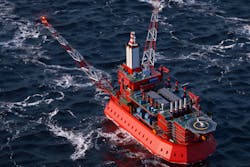Offshore staff
MOSCOW – Construction has started on a new ice-resistant platform (ICP) for Gazprom’s Kamennomysskoye-Sea gas field development in the Ob Bay region of the Kara Sea, offshore northern Russia.
The field, operated by Gazprom Dobchya Yamburg, contains estimated resources of 555 bcm and is due to start production in 2025. The platform will have a design output (for the Cenomanian interval deposits) of 15 bcm/yr.
Kamennomysskoye-Sea is in an area subject to very low temperatures (up to -60°C/-76°F), severe storms, shallow water depths (5-12 m), and thick, dense freshwater ice.
According to Gazprom, this will be the first shelf project in the world in such extreme ice and climate conditions.
The ICP will be over 135 m (443 ft) long, 69 m (226 ft) wide, 41 m (134 ft) tall from the base to the helicopter pad, and with a total weight of over 40,000 tons. Onboard equipment will include main and auxiliary drilling modules, operational and energy complexes, and living quarters for 120 people.
Gazprom plans to use the facility to initially drill 33 directional production wells followed later by a further 22 wells for maintaining production rates: these will be placed on satellite ice-resistant conductor platforms that do not require permanent manning.
Produced gas will be sent through pipelines to the shore for delivery to a gas treatment unit and a booster compressor station, followed by onward export through Russia’s Unified Gas Supply System.
Shipbuilding research institutions in Russia undertook all modeling and design for the ICP. The construction process, currently under way at the Southern Shipbuilding and Repair Center shipyard in the Astrakhan region, will involve implementing measures designed to ensure a high level of industrial and environmental safety and operational integrity of the facility, Gazprom said.
To protect the ICP from thick ice, the support structure will be V-shaped, and most of the platform’s equipment will be encased in the hull to provide protection from cold and wind.
The ICP will initially be fixed to the muddy bottom of Ob Bay using a piled gravity base foundation, then stationed on the seabed. The underwater part of the platform will be filled with seawater and secured via 56 piles with a diameter of over 2 m (6.6 ft), all driven 47 m (154 ft) into the seabed.
To safeguard local Arctic flora and fauna, the facility will include a zero discharge system, and all production waste will be removed from the platform and disposed of later.
To build a facility of such technical complexity, Gazprom added, various Russian shipbuilding and machine-building centers are participating in the project. Separate components of the platform will be simultaneously constructed in Astrakhan, Kaliningrad, Severodvinsk, Yekaterinburg, and Rybinsk, and the ICP will be finally assembled in one piece in Kaliningrad.
During the summer 2024 local navigation period, the completed ICP will be towed to the field, after which flare booms and a helicopter pad will be set up at the facility.
Around 7,000 Russian construction workers and technical specialists will be involved in the project.
Gazprom has established an integrated project office that brings together representatives of the relevant divisions of Gazprom, Gazprom Invest (sole technical customer), Krasnoyarskgazprom Neftegazproject (general designer and contractor for the construction of the platform), and Gazprom Dobycha Yamburg (operator and holder of the exploration and production license).
07/01/2020



